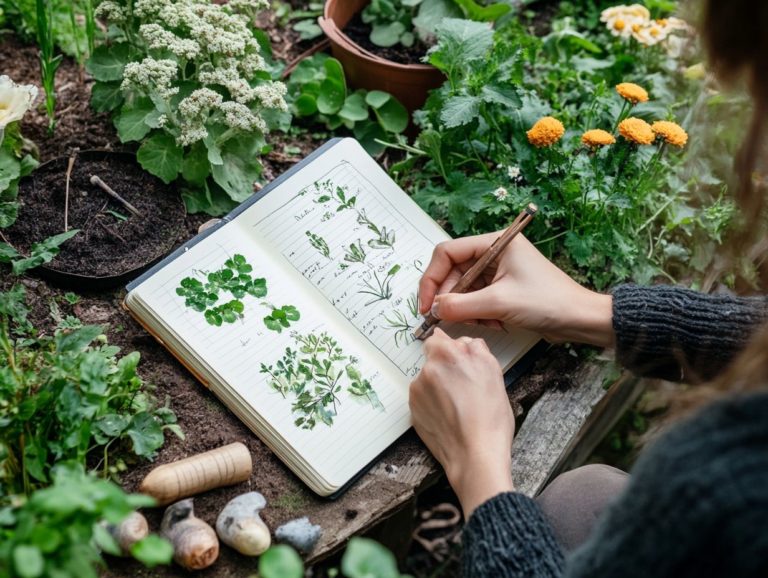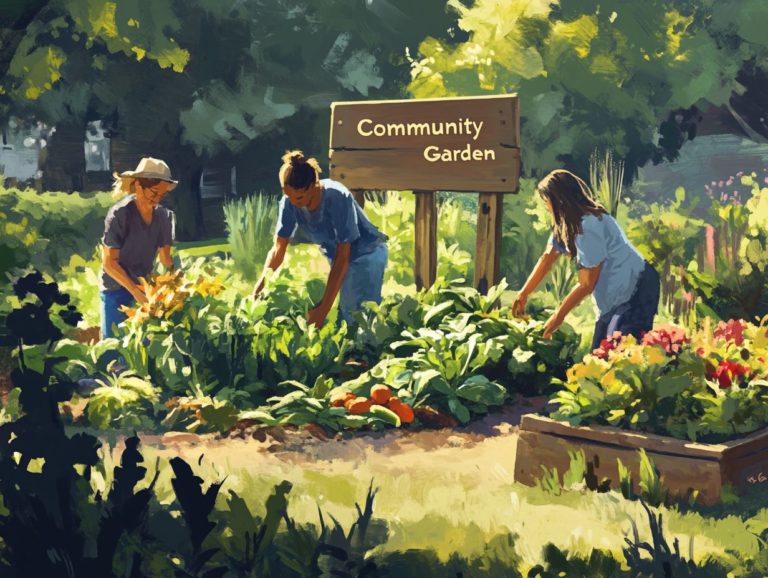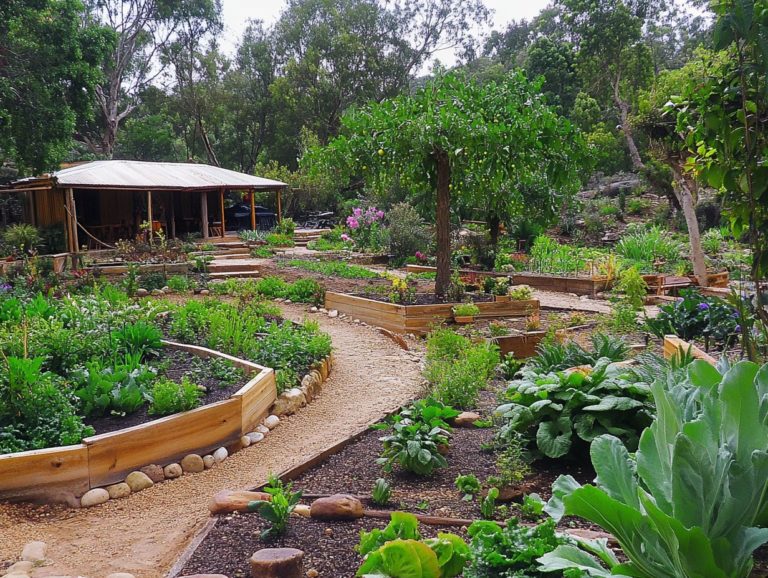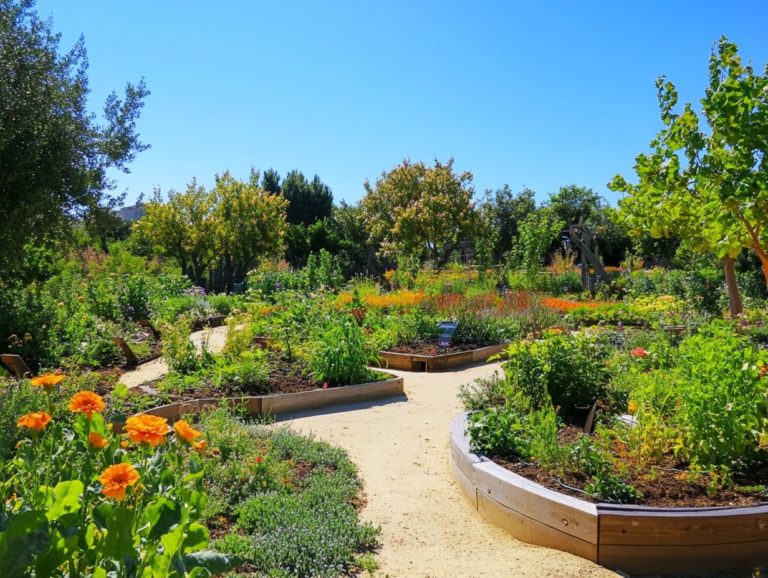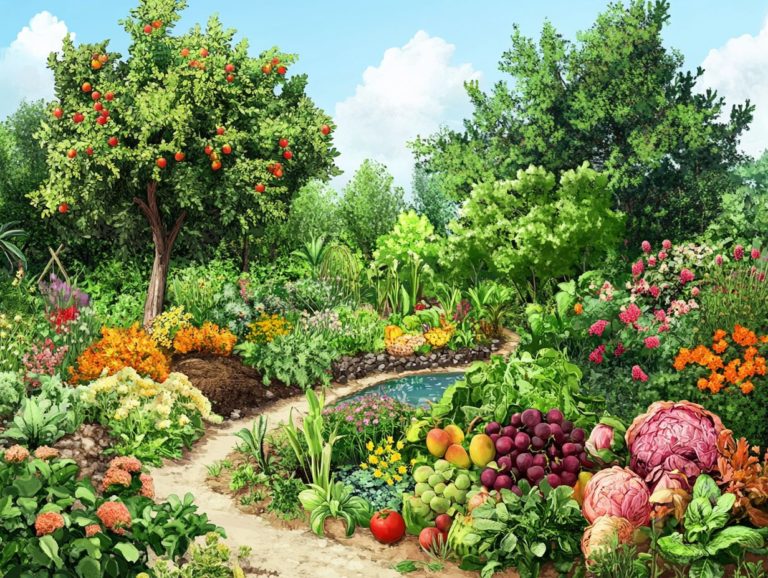How to Use Mulching in Permaculture Design
Mulching is an essential practice in permaculture design. It delivers a wealth of benefits that significantly boost both soil health and garden productivity, aligning with principles of regenerative agriculture.
This article delves into the essence of mulching. You will discover advantages like water conservation and effective weed control, as well as the various types available, including natural ecological options.
Whether you prefer organic or inorganic choices, you ll find expert guidance on selecting the ideal mulch to suit your specific needs in your urban forests or backyard.
You will also discover proper application techniques and how to sidestep common pitfalls. Additionally, learn to troubleshoot issues like pests and diseases that may affect your healthy soil.
Dive in now to see how mulching can transform your garden and enhance its biodiversity and productivity!
Contents
- Key Takeaways:
- What is Mulching?
- The Benefits of Mulching
- Types of Mulch
- How to Apply Mulch in Your Permaculture Design
- Common Mistakes to Avoid
- Troubleshooting Mulching Issues
- Frequently Asked Questions
- What is mulching and why is it important in permaculture design?
- How do I choose the right type of mulch for my permaculture design?
- How do I apply mulch in my permaculture design?
- How often should I replenish my mulch in a permaculture design?
- Can I use mulch in all areas of my permaculture design?
- What are some other benefits of using mulch in permaculture design?
Key Takeaways:
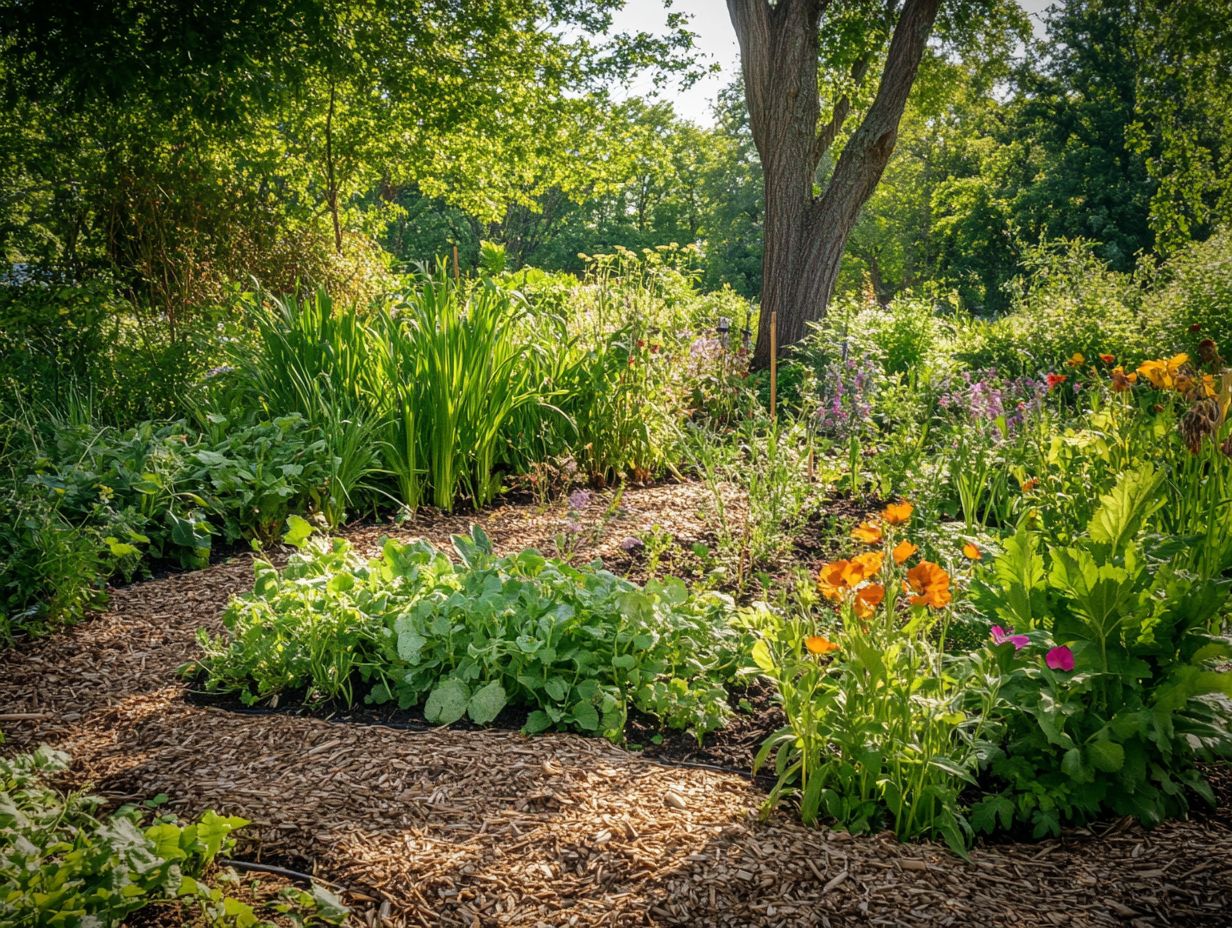
- Mulching helps improve soil health, conserve water, and control weeds in permaculture design, making it a key practice in biodynamic gardening.
- Choosing the right type of mulch, whether organic or inorganic, is important for specific needs and conditions, especially in achieving the right carbon nitrogen ratio.
- Proper application techniques and avoiding common mistakes ensure successful mulching in permaculture, particularly with cover crops and composted manure.
Embrace mulching to elevate your garden’s potential!
What is Mulching?
Mulching is a vital practice in organic gardening and permaculture. It involves covering the soil with different materials to enhance soil health, conserve water, and foster biodiversity.
By using this technique, you create a system where materials like composted manure and leaf litter are recycled within your garden. This process boosts nutrient levels in the soil and supports healthier crop plants.
The Benefits of Mulching
The benefits of mulching extend beyond visual appeal. They are crucial for improving soil health, conserving water, and managing weeds, aligning seamlessly with the principles of organic gardening.
Incorporating materials such as living mulches and cover crops not only enhances your garden’s appearance but also cultivates a vibrant ecosystem that supports biodiversity.
Improving Soil Health
One of the most significant benefits of mulching is improving soil health. Adding compost and organic matter elevates the organic matter content and creates a habitat for essential microorganisms.
By using composted manure and various organic mulches, you can boost soil fertility and enhance biodiversity. This creates a thriving living ecosystem that nurtures healthy crop plants.
As organic matter decomposes, it enriches the soil with vital nutrients while regulating temperature and moisture. These factors are critical for microbial activity, which ultimately supports plant growth.
A diverse selection of plant species in a mulched setting encourages a range of soil-dwelling organisms. This promotes nutrient cycling and strengthens resilience against pests and diseases, maintaining a balanced ecosystem essential for sustainable agriculture.
Conserving Water and Controlling Weeds
Mulching is essential for conserving water and controlling weeds. It offers substantial benefits for your organic gardening endeavors. By incorporating organic materials like silt, cereal husks, and woody prunings, you can create a protective barrier that retains soil moisture while effectively suppressing unwanted weed growth. This ultimately enhances the absorption of nutrients by your plants.
The selection of mulch material is critical. It directly impacts both moisture retention and the microbial health of your soil. For example, organic choices such as straw and bark chips not only thwart weed germination but also break down over time, enriching your soil with valuable nutrients.
Regular evaluation of mulch thickness and quality is necessary to maintain optimal moisture levels and manage weed growth. By thoughtfully applying mulching practices, you can significantly bolster the overall health of your garden ecosystem. This paves the way for more productive and sustainable gardening outcomes.
Types of Mulch
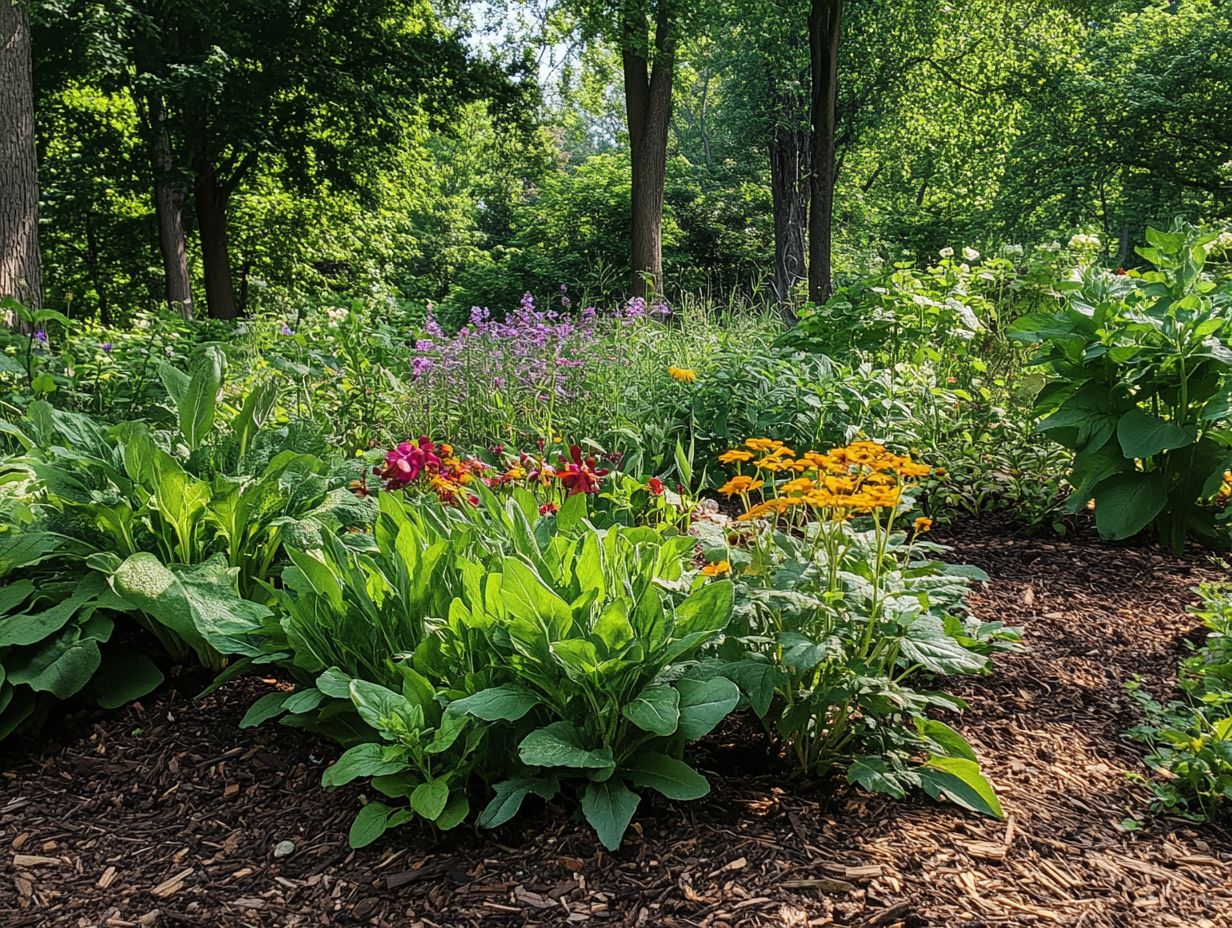
Understanding the different types of mulch is crucial for effective garden design that works with nature. Both organic and inorganic options bring unique advantages to biodiversity and ecosystem services.
Organic mulches think leaf litter, black soldier fly larvae, and greater burdock not only enrich the soil but also foster tiny living organisms that help the soil. In contrast, inorganic materials, such as stones and plastics, fulfill distinct roles that can complement your overall strategy in a sustainable ecosystem.
Organic vs Inorganic
Organic mulch, crafted from natural materials, offers a wealth of benefits for soil health and biodiversity. In contrast, inorganic mulch presents its own unique advantages and considerations, especially within permaculture systems. You might find organic options such as compost, leaf litter, and woody prunings. Meanwhile, inorganic choices like plastic or stones fulfill specific roles in your garden layout.
Your choice between these two types significantly influences not only soil vitality but also the entire ecosystem of your garden. Organic mulch enhances moisture retention and enriches the soil with essential nutrients as it decomposes. This fosters a vibrant microbial community. On the other hand, while inorganic mulch can minimize weeding and lend a tidy appearance, it may disrupt natural interactions and alter soil temperature dynamics.
Understanding these factors can empower you to make impactful choices that resonate with your environmental values and gardening aspirations. This ultimately paves the way for a more sustainable practice.
Choosing the Right Mulch for Your Needs
Selecting the right mulch for your gardening needs is essential for optimizing soil health and enhancing the sustainability of your garden design. Consider factors such as the types of plants you re growing including nitrogen-fixing varieties local climate conditions, and the aesthetics you desire. Each of these elements plays a significant role in determining the effectiveness of your organic or inorganic mulch choices in promoting ecosystem services.
By understanding your garden s specific requirements, you can achieve improved moisture retention and better weed control. This ultimately boosts plant health and productivity. Whether you’re aiming to cultivate beneficial microorganisms in the soil or create a visually stunning landscape, the right mulch serves as a protective barrier against extreme temperatures while enriching the soil beneath over time.
With a variety of mulches available such as wood chips, straw, or compost each offering distinct benefits, your selection process should align not only with the specific plants in your garden but also with your overarching goals for a sustainable ecosystem.
How to Apply Mulch in Your Permaculture Design
Applying mulch correctly in your garden design is essential for attaining optimal soil health and enhancing overall garden productivity. Start by preparing your soil carefully. Choose high-quality mulch materials like composted manure or living mulches and apply them thoughtfully. This promotes moisture retention while simultaneously encouraging biodiversity.
Step-by-Step Guide
A step-by-step guide to applying mulch effectively can elevate your permaculture practices and significantly improve soil health. Begin by selecting the right type of mulch. Prepare the soil by making holes in it to help air and nutrients get in, and apply compost. Finally, spread an even layer of mulch to maintain moisture and suppress weeds.
Proper soil preparation is essential. Start by clearing away any existing weeds or debris to establish a clean foundation. Aerating the soil allows oxygen and nutrients to penetrate freely, which is vital for the development of plant roots.
Next, consider the various types of mulch available, such as organic materials like straw, wood chips, and greater burdock. Each offers unique benefits. When applying the mulch, aim for a depth of about two to four inches and keep it away from plant stems to prevent rot.
This careful application enhances moisture retention, reduces temperature fluctuations, and creates an ideal environment for beneficial microorganisms, ultimately supporting a thriving ecosystem.
Common Mistakes to Avoid
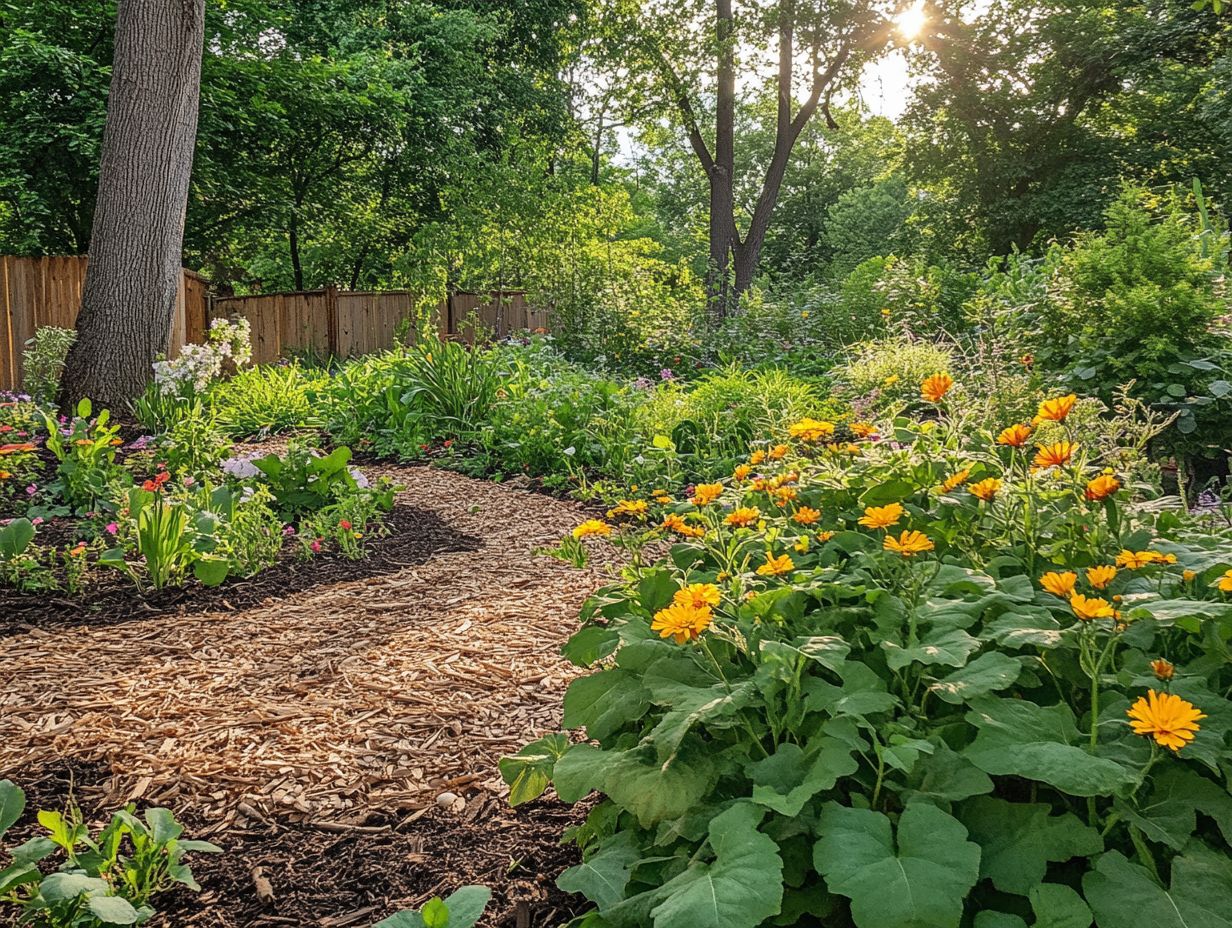
Avoiding common mistakes with mulching is crucial for preserving soil health and maximizing the effectiveness of your organic gardening and permaculture endeavors. Many gardeners underestimate the significance of proper mulch depth or select unsuitable materials. These mistakes can stifle growth and disrupt the delicate balance of the ecosystem.
Focusing on these details will ensure your garden thrives harmoniously, contributing to its overall biodiversity and health.
Proper Mulching Techniques
Mastering mulching techniques will transform your garden into a flourishing paradise! Focus on maintaining the right mulch depth, ensuring that it doesn t come into direct contact with plant stems, and selecting materials that enhance soil health, like compost or leaf litter.
It s crucial to regularly monitor moisture levels and adjust the mulch thickness. This helps strike the perfect balance, preventing both excess evaporation and moisture retention.
Over time, the organic materials you choose will decompose, enriching the soil with vital nutrients and nurturing a thriving ecosystem for beneficial microorganisms. By opting for a variety of mulch types, you can increase biodiversity, supporting healthier plants across your garden.
Adding a layer of mulch around your plants suppresses stubborn weeds, allowing your young crops to flourish without competition. This ultimately paves the way for a more productive and sustainable garden while providing essential plant food.
Troubleshooting Mulching Issues
Troubleshooting mulching issues is crucial for sustaining soil health and creating a flourishing garden environment. You may encounter common challenges such as pest infestations, diseases stemming from improper mulching, and nutrient imbalances that can impact your crops and overall biodiversity. The introduction of black soldier fly larvae can also help manage pests.
Act now to tackle these issues and let your garden thrive!
Dealing with Pests and Diseases
Navigating pests and diseases in your mulching efforts requires a solid understanding of organic gardening principles and the complex dynamics of your ecosystem. To manage this effectively, consider strategies like choosing pest-resistant plants, ensuring the proper depth of your mulch, and adding compost. Incorporating woody prunings can also help. These steps create a balanced environment that discourages harmful organisms.
Focus on organic methods to create a lively habitat for your plants where beneficial insects and microorganisms thrive, boosting plant vitality. Techniques like crop rotation changing the types of plants grown in a specific area each season companion planting, and using cover crops further reduce the risk of infestations and diseases.
Maintaining a diverse mulch composition such as leaves, straw, wood chips, or even cereal husks enriches your soil and serves as an effective barrier against pests. Regularly refreshing your mulch is essential to prevent the buildup of fungal pathogens, paving the way for a healthier, more resilient garden ecosystem.
Final Thoughts and Recommendations
Effective mulching practices are crucial for success in organic gardening and permaculture. They offer many benefits, including improved soil health, water conservation, and efficient pest management. By learning about different types of mulch, mastering application techniques, and understanding potential challenges, you can create a flourishing ecosystem that promotes biodiversity and ecosystem services.
These practices help reduce weed growth and regulate soil temperature, creating a better environment for your plants. As you implement these strategies, select materials suited to your local availability and specific garden needs. Transitioning to organic methods connects you with nature and emphasizes the importance of sustainability.
Actively assess your mulching now for the best results. By embracing these actionable recommendations, including adding ground cover plants, you can cultivate a more resilient landscape. Understanding the role of plants in permaculture design ensures both immediate and long-term benefits for your organic gardens and permaculture projects.
Frequently Asked Questions
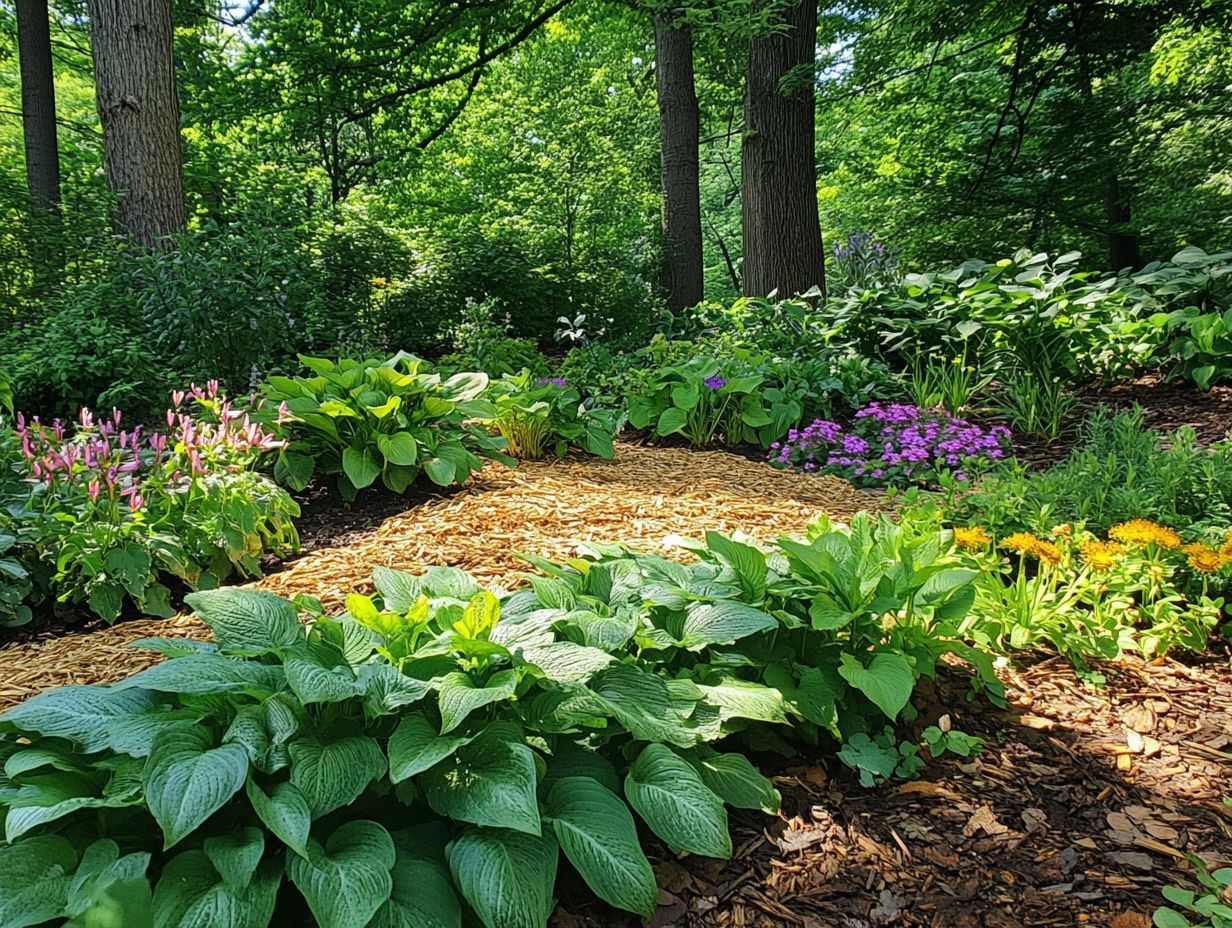
Here are some common questions about mulching in permaculture:
-
What is mulching and why is it important in permaculture design?
Mulching is covering the soil with a layer of organic material like leaves, grass clippings, or wood chips. It’s important because it improves soil health, retains moisture, suppresses weeds, and provides nutrients for plants.
-
How do I choose the right type of mulch for my permaculture design?
The right mulch depends on factors like the plants you’re growing, your climate, and material availability. Common types include straw, shredded leaves, and wood chips.
-
How do I apply mulch in my permaculture design?
Apply a layer of 2-4 inches of mulch on top of the soil. Leave a small gap around the base of plants to prevent moisture buildup and potential rot. Use a rake to spread it evenly.
-
How often should I replenish my mulch in a permaculture design?
The frequency depends on the type of mulch and your climate. Generally, organic mulches need replenishment every 6-12 months, while inorganic options like gravel may last longer.
-
Can I use mulch in all areas of my permaculture design?
Yes, you can use mulch in both garden beds and pathways. In garden beds, it improves soil health and nutrients for plants, while in pathways, it suppresses weeds and enhances appearance.
Start mulching today for a better garden!
What are some other benefits of using mulch in permaculture design?
Using mulch improves soil health and keeps weeds at bay. It also helps regulate soil temperature, prevents erosion, and draws in helpful bugs and tiny organisms that boost your garden’s health.
This practice is sustainable, cutting down the need for chemical fertilizers and herbicides. Embracing mulch, along with understanding how to use perennials in your permaculture garden, can transform your design into a thriving ecosystem!

